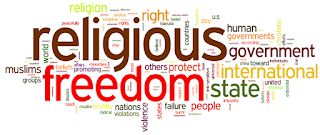Religious freedom is protected under Article 9 ECHR. The balancing of this right tends to favour individuals who align with the values inherent in the ECHR, for instance, by protecting someone from harm or discrimination. Here, minorities rights have prevailed over Article 9 rights. However, religious freedoms of minorities have been restricted in light of majoritarian interests, even where majority rights have not been at stake. This demonstrates that minorities rights are only protected if they align with the values of the ECHR, but if they are not at risk from harm or discrimination, they are denied their Article 9 right, ultimately suppressing multi-culturalism.
Religious freedom restricted to protect minorities at risk
The ECtHR has restricted Art 9 if it interferes with an inherent ECHR value, for instance where the exercise of religious freedom discriminates against a minority group. In Ladele, the ECtHR placed weight on how employing someone against same-sex marriage at a marriage registrar can give the appearance that the registrar is unwelcoming towards same-sex couples. This discriminates against these couples as they are limited in where they can marry, causing them to feel even more vulnerable and unwelcome.
The domestic courts followed similar rhetoric in Bull v Hall. The Supreme Court held that the B&B owners’ Christian conscience could be restricted as it had manifested into discrimination against same-sex couples. In her judgement, Lady Hale emphasised how conscience cannot be a vehicle for discrimination against others, especially when the ground of discrimination is one that is still being targeted. Here, there was a need to assure homosexual people that they are worthy of equal respect and esteem, whereas Christianity had not been marginalised in the same way. This emphasises how minority interests can be protected if they align with values inherent in the ECHR.
Conversely, in Ashers v Lee, freedom of religion prevailed when a Christian bakery refused to serve a cake saying ‘Support Gay Marriage’ to a gay man. This shows that minority rights may not even be protected despite being inherent values of the ECHR. However, here, it is argued that religious freedom did not prevail, but the freedom of speech. The bakery was not discriminating against Lee himself, rather they did not want to write the specific message. Thus although Fraser-Butlin believes this case was a vital affirmation of the freedom of conscience and speech, it is argued that the manifestation of religious conscience is usually restricted where it discriminates against minority people, but a higher threshold remains before freedom of speech can be restricted. This follows Foster’s view which suggests that Ashers only applies to speech, not the right to discriminate or treat individuals differently.
Religious freedom restricted to protect majoritarian agendas
Where an individual is not at risk of traditional forms of discrimination like being denied service or treated differently, the Court tends to restrict minority religious beliefs, even if there are no competing minority rights at stake. The most significant cases involve religious clothing, in particular, Islamic dress. Here, the ECtHR will allow states to restrict these rights, perhaps as the ECtHR does not view these rights as inherent in the ECHR. For instance, in Ebrahimian v France, a nurse was lawfully dismissed for refusing to take off her headscarf, and in Dahlab v Switzerland, a teacher wearing a headscarf at school could not be reconciled with tolerance and equality as the scarf might have ‘some kind of proselytising effect’. It is argued that these cases demonstrate greater intolerance and inequality towards minority religions, as children and patients are surely exposed to other religions outside of these contexts so would not be overly proselytised by seeing a headscarf.
Possibly the most important case in demonstrating that the ECtHR does not protect minority religious groups if they do not align with ECHR values is SAS v France. Here the religious freedom to wear the burqa in public was restricted to allow for ‘living together’, which was linked to the legitimate aim of protecting the rights and freedoms of others in Art 9(2). Justifications for this restriction may be that France particularly protects the ‘laïcité’ state for greater integration and socialisation, so wearing the burqa may potentially hinder communication and approachability.
However, it is argued that banning the burqa will not affect ‘living together’ given that fewer than 2000 Muslims in France wear the face veil, in a population of 67 million. Socialisation is not a compulsory activity, and Adentire notes that it is doubtful that people have a general right to a society free from barriers to social interaction. Moreover, although the Court rejected the argument of ‘gender equality’, it is not improbable that the ‘living together’ argument was used to impose Westernised standards for women’s clothing, ‘freeing’ Muslim women from the veil. On this basis, by ‘freeing’ women, France is actually subjecting women who choose to wear the veil to exposure and vulnerability, further victimising them by restricting their choice. This case stands in contrast to Eweida, where the ECtHR overruled the domestic court, finding it was disproportionate to ban Eweida’s crucifix at work. This shows the lenient approach of the ECtHR to majoritarian religions where there are no competing rights.
Impact on multi-culturalism
The impact of the ECtHR only protecting rights where they align with the ECHR values has indeed suppressed multi-culturalism. After SAS, the Open Society Foundation found that most full veil wearers have become less sociable since the ban, many have reduced their outdoor activities and some feel like they are ‘in jail’. The ban has thus become a greater barrier to ‘living together’. This has impacted multi-culturalism by conveying a message of Islamophobia; in SAS the Court stated they are ‘aware that the clothing in question is perceived as strange’, emphasising existing prejudices against Muslim women, rather than protecting them from bias. Brayson argues that controlling and regulating Islamic women’s bodies is an example of colonial assimilation, supported by the fact that clinical face masks (even pre-COVID) are acceptable in society and do not affect ‘living together’. Mechoulan argues that this is because face masks do not carry religious ideology, and this undermines the ‘living together’ argument which concerned ease of communication rather than religion. Thus, as face masks are evidently allowed to be worn in public without preventing ‘living together’, it is clear the Court has projected Islamophobic majoritarian views onto Muslim people, supporting the view multi-culturalism has been suppressed.
SAS can be contrasted to Ashers, where the exercise of Christian speech prevailed even at the expense of minority rights being infringed. In SAS however, the claimant could not exercise her right to religious clothing - perhaps less of an interference than speech - despite her not infringing on any minority rights (and arguably majority rights). Even if the real reason for the burqa ban is to combat traditional values of gender oppression in Islam, surely the same could be applied in Ashers where traditional Christian views are oppressing same-sex couples? The fact these cases have opposite outcomes highlights that the issue is not ‘living together’, but Islamophobia.
In conclusion, the ECtHR has protected minority interests only where they align with inherent ECHR values, demonstrating that in many cases, minority religions are not afforded the same protection as majority religions. This is indicative of a human rights model that has continuously overlooked minority groups in favour of populist agendas, for instance regarding migrants rights under Article 8 and Article 4 ECHR. In the religion context, the model only restricts majority religions where they marginalise other groups, whereas minority religions are restricted simply because they do not fit the social expectation of the country. This suppresses multi-culturalism and further discriminates against the most vulnerable groups.
The writer, Simrhan Khetani, is a law graduate from the University of Cambridge and future trainee solicitor at Akin Gump LLP. She has a keen interest in Equity and Trust law and will be pursuing this interest in her work as a solicitor.
Law Tutors Online, UK Law Tutor, UK Law Notes, Manchester Law Tutor, Birmingham Law Tutor, Nottingham Law Tutor, Oxford Law Tutor, Cambridge Law Tutor, New York Law Tutor, Sydney Law Tutor, Singapore Law Tutor, Hong Kong Law Tutor, London Tutors, Top Tutors Online and London Law Tutor are trading names of London Law Tutor Ltd. which is a company registered in England and Wales. Company Registration Number: 08253481. VAT Registration Number: 160291824 Registered Data Controller: ZA236376 Registered office: Berkeley Square House, Berkeley Square, London, UK W1J 6BD. All Rights Reserved. Copyright © 2012-2024.


